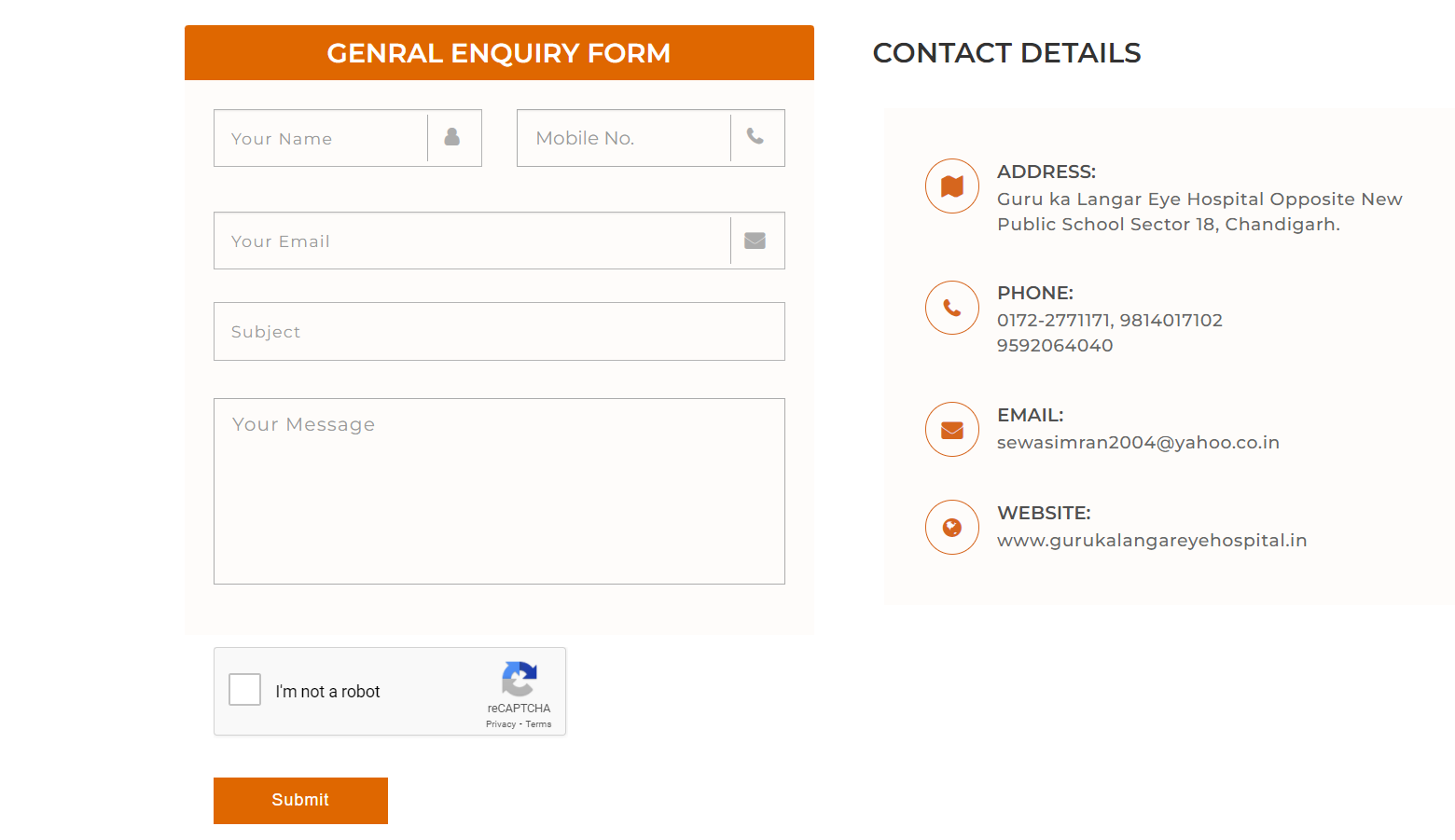The Guru ka langar eye hospital is located in Sector-18 in Chandigarh, directly across from the New Public School. A team of committed professionals founded the Sri Guru Granth Sahib Sewa Society in 1997 with the Bakshish of Guru Nanak Dev Ji. We have grown into a major organization with around twenty-five executive officers, 45 doctors, 100 paramedics, 4 hospitals, and ten ambulances in a brief period.
The hospital’s major goal is to provide top-notch medical care at no cost to the underprivileged, destitute, and general populace on a no-profit, no-loss basis. During therapies and treatment, food and accommodation are also provided to patients along with guardians that too free of cost. Although, you are free to donate according to your abilities and no one is forced to do so.
Contact Info: 0172-2771171
9592064040, 9814017102
Address: Guru ka Langar Eye Hospital, Opposite New Public School Sector -18, Chandigarh.
E-mail: [email protected]
Website: http://www.gurukalangareyehospital.in/
If you are also seeking medical help or treatment for your eye you can contact them via the above-mentioned information. Also generally you can fill out the form and ask questions you are concerned about.

Treatments provided by Hospital are:
Cataract – Phaco-Emulsification
Phacoemulsification is a procedure for liquefying and removing cataracts from the inside of the eye using specialized equipment called a Phacoemulsification unit. A titanium needle pulsating at a frequency of even more than 40,000 times a second is used to perform the cataract surgery through a 1.8 to 2.8 mm incision. Cataract extraction with the Phaco-emulsification procedure is conducted through a 1.8 mm to 2.8 mm opening only, however, in the ECCE Cataract surgery, the incision is between 8mm and 10mm.
Diabetic Retinopathy
Diabetic retinopathy is a leading cause of blindness in people with diabetes. It is divided into two categories. Proliferative retinopathy is characterized by the formation of new blood vessels on the retina’s surfaces, which can result in retinal bleeding and scarring. Edematous or background retinopathy is another kind of retinopathy that induces vision loss due to leakage of tiny blood vessels in the retina. The only appropriate cure for diabetic eye proliferation is a laser. If only the central vision is impacted, one Laser treatment session is usually sufficient. If new blood vessels appear, the eye is separated into four quadrants and a whole PRP, i.e. four laser sessions, is performed.
ICG And FFA (Retina)
Fluorescein Angiography is a straightforward but precise test for determining the condition of the retinal blood vessels. In this assay, they infuse a small amount of fluorescein intravenously through a cannula and use a fundus camera to capture fast photographs of the retina. The dye in the procedure will leak out of abnormal blood vessels. As a result, this test determines how much laser should be used and where it should be applied.
Cornea Transplant
A cornea transplant is a procedure that substitutes damaged or scarred cornea tissues with normal tissue from a healthy donor. Conventional full thickness cornea transplants also referred to as penetrating keratoplasty, and rear layer cornea transplants also referred to as endothelial keratoplasty, are the 2 kinds of cornea transplants.
Amblyopia (Lazy eye)
Amblyopia is a condition in which your brain favors one eye over the other, usually due to impaired vision in another. Your brain may ultimately dismiss messages from your weakened, or “lazy,” eye. The illness can cause vision problems as well as a loss of depth awareness.
Glaucoma
Glaucoma is a collection of eye diseases that affect the optic nerve, which is essential for proper vision. Excessively high pressure in your eye is often the source of this impairment. If glaucoma is detected early enough, vision loss can be reduced or avoided. You’ll almost certainly need treatments for the remainder of your life if you have the disease.
Squint eyes
Squint eyes are an ailment wherein the eyes do not conform correctly. They are not looking in the same way. The condition is caused by a lack of eye muscle strength. Other causes include poor eye muscle harmony, faulty nerve sensory information to the eye muscles, and concentrating issues usually long sight. Eyeballs could converge or diverge as a result of these abnormalities, obstructing appropriate eye function.
Oculoplastics
Oculoplastics is a subspecialty of ophthalmology that focuses on irregularities of the eye’s nearby tissues. Oculoplastic surgeries might be either a medical or a cosmetic requirement. They are suitable for persons of all ages. The oculoplastic procedure begins with a thorough eye assessment to determine the patient’s present state of vision. It will allow the ophthalmologist to gain a better knowledge of the patients’ vision problems.
Pediatric Ophthalmology
Since a child’s eye is still undeveloped and evolving, it differs from that of an adult. The appropriate growth of the eye, as well as strong ties between the eye and the brain, are required for effective vision. As a result, any issue affecting the child’s eyesight should be addressed as soon as possible. This is the primary reason that pediatric ophthalmology has developed into a distinct subspecialty.
Services Offered by Guru ka Langar Hospital:
- FREE EYE CAMPS
- FREE EYE OPD
- FREE EYE SURGERIES
- FREE TREATMENT
- FREE OCT
Not just for eye treatments but for all possible social works Guru ka langar hospital and trust is very well known. Even during the peak of the pandemic Covid-19, they have provided langar and assistance to Covid patients for free. Covid-19 patients under residential isolation are received 24-hour care at Guru Ka Langar Eye Hospital in Sector 18, Chandigarh. Oxygen cylinders, pulse meters, and oxygen concentration equipment are among the items they provide.
“We have offered langar since last year, and now we have launched this project,” said HS Sabharwal, secretary of the Sri Guru Granth Sahib Sewa Society, which manages the hospital. Up to this point, we’ve given Covid patients 65 oxygen cylinders and roughly 250 oximeters the in the Tricity.”








